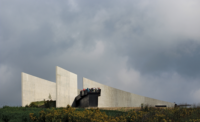Envisioning a 93-ft-tall precast concrete wind chime for the Flight 93 National Memorial near Shanksville, Pa., architects Paul and Milena Murdoch couldn’t imitate the more familiar approach featuring a single external chime striker surrounded by chimes. Their unique design uses a complex internal mechanism careening inside 40 large-scale cylindrical chimes, each one representing a passenger or crew member who died on that United Airlines jet on Sept. 11, 2001.

The Tower of Voices also evokes the 37 final phone calls from Flight 93 to loved ones before efforts began to fight off terrorists believed to be planning to crash the plane into the U.S. Capitol. The Murdochs, partners in marriage and as executives of Paul Murdoch Architects, didn’t want the stainless steel strikers to visually associate with the hijackers. Instead, each chime has its own striker and “inner voice,” says Paul Murdoch, the firm’s founder and president; Milena is vice president. “We felt symbolically that was truer to the memorialization we were after,” he says.
The concept for what is believed to be the world’s largest grouping of tuned wind chimes presented technical challenges. Strikers inside the 8-in.-dia chimes have to project the intended sounds in varying wind conditions within a two-octave range despite their tightly confined radius inside the tubes. Cracking that code involved experts who don’t typically collaborate—including a musician and tuning theorist, a chimes artist, acoustical and structural engineers and wind consultants. Using musical tuning theory, the team tested tower shapes with computational fluid-dynamic modeling, simulated variable wind conditions with wind tunnel tests and performed 3D audio simulations of chime configurations at Arup SoundLab in Los Angeles. Built on mining spoils, the tower also had a geotechnical engineer.
PennStress fabricated 53 precast concrete segments, including beams connecting the columns that were installed at a 40° angle to represent the branches of the park’s hemlock trees. Beam design also optimizes airflow. Greg Gorman, PennStress chief operating officer, called Murdoch a “visionary” who successfully communicated his “great idea and great design.”
A Pennsylvania native who won an international competition in 2005 to design the phased memorial—including a wall of names, visitor and education centers and a flight-path walkway to the crash site—Murdoch developed a rapport with Flight 93 families, who raised $400,000 for the project, says Stephen Clark, memorial superintendent. Families “have tremendous … appreciation” for Murdoch’s efforts, he says.
Eight prototype chimes were installed and rung manually at a Sept. 9, 2018, dedication, which Murdoch calls “a moment I will always remember.” While “getting optimal sound out of all the range is something we’re still working on,” the team has come far from the prototype testing in Simi Valley, Calif., last year, he says. Unable to get an internal striker to produce sound, the crew rigged an external striker before Murdoch arrived at the test site. Dismayed, he calmly reiterated the internal striker’s symbolic importance and asked the crew to reset it. “I’m not sure what made the difference, but the wind came up a little bit and we started to hear this beautiful resonant sound,” he recalls. “They’re all looking at each other like ‘no way,’ and I just said, ‘That’s the most beautiful sound I ever heard. That’s exactly what we want.’ ”





Post a comment to this article
Report Abusive Comment